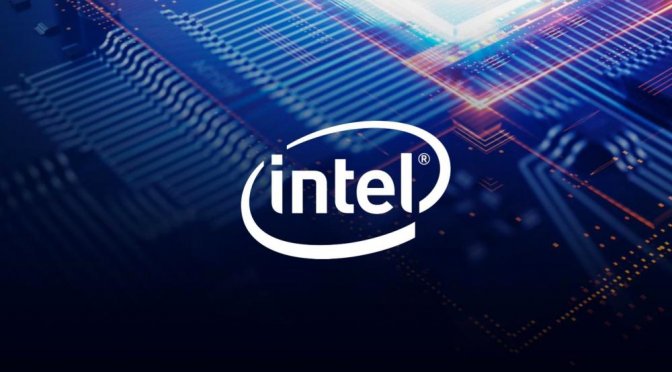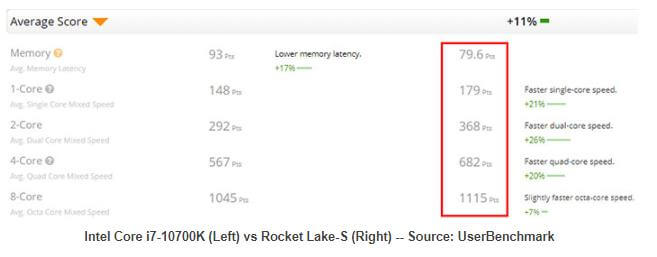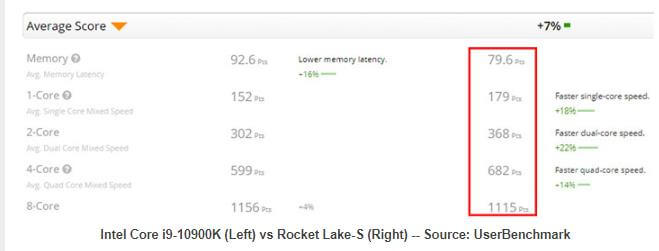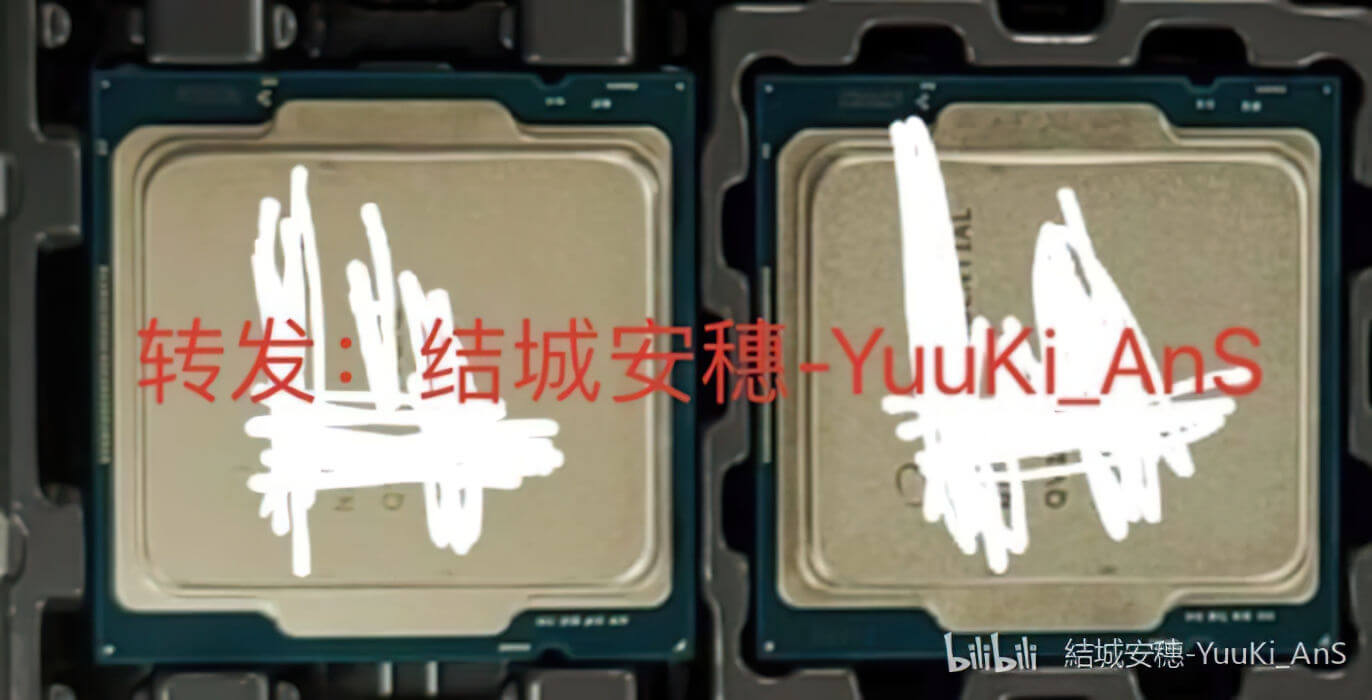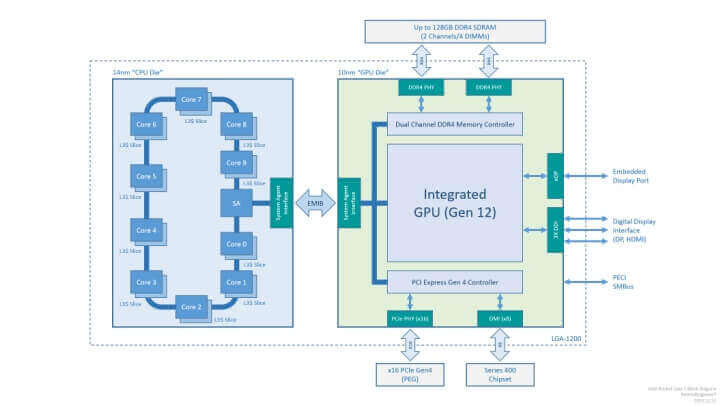Just few days ago, Intel officially revealed its upcoming 11th Gen Rocket Lake-S desktop CPU lineup, based on the Cypress Cove core architecture. Rocket Lake (RKL) is a planned microarchitecture designed by Intel as a direct successor to the Comet Lake-S series of desktop CPUs and high-performance mobile devices.
RKL processor family will release in the first quarter of 2021, and is expected to share the same socket and motherboard compatibility as the current 10th Gen Comet Lake processors, thus providing an upgrade path even for those rocking the flagship Core i9-10900K Comet lake CPU.
Rocket Lake-S desktop platform should hopefully be the last CPU architecture to be based on an advanced 14nm process node. The new Rocket Lake-S silicon or SoC is going to be known as ‘Cypress Cove’.
Rocket Lake-S will offer PCIe Gen 4.0 support, enhanced overclocking and double-digit percentage IPC benefits over Comet Lake-S lineup. Intel’s Rocket Lake will use a 14nm back-port of the 10nm Sunny Cove cores found in the Ice Lake processors. With Rocket Lake processors, Intel is targeting a raw instruction-per-clock uplift in the double digit range.
Now we have some early leaked benchmarks to back up this claim. If the recent UserBenchmark results are accurate, we might be looking at improvements of up to 21%, over previous gen CPU lineup. These UserBenchmark entries were spotted and shared recently by a known hardware leaker, @Tum_Apisak.
MSI Z590-A PRO-12VO (MS-7D10)
Intel 0000
U3E1, 1 CPU, 8 cores, 16 threads
Base clock 3.4 GHz, turbo 4.2 GHz (avg)Rocket lake🤔https://t.co/ryJbIvYIjz pic.twitter.com/0PynjFXLtt
— APISAK (@TUM_APISAK) October 30, 2020
A presumed Rocket Lake-S processor running on an MSI’s Z590-A PRO-12VO (MS-7D10) motherboard shows some promising results. Since the RKL CPU lineup will max out at 8 cores/16 threads, the octa-core processor from this UserBenchmark submission is likely the flagship core chip.
The entry spotted is an engineering sample (ES) chip with 8 physical cores and 16 threads. According to the database entry, it has a 3.4 GHz base clock and 4.2 GHz boost clock speed value. So expect the final silicon to boost/clock even higher since this is an ES sample. Rumor has it that the flagship RKL chip can even hit an all-core turbo clock of 5 GHz and up.
i9 RKL can turbo to 5.4-5.5(ES2 5.3), I guess i7 is around 5.0-5.2. https://t.co/RMyAxWnNfT
— 猫比优斯 (@MebiuW) October 12, 2020
This RKL CPU scored a single-core score of 179, and 368 for two cores, 682 for four cores, and 1,115 for eight cores. Let us compare these scores with the Core i7-10700K CPU, an 8C/16T, 3.8 GHz to 5.1 GHz Comet Lake SKU.
Compared to the Core i7-10700K, the Rocket Lake-S in this benchmark scored 22 percent higher in one core test, 26 percent higher with two cores, 20.3 percent higher with four cores, and finally 7 percent higher in the eight cores test.
Similar gains can be seen when comparing it against the Core i9-10900K CPU (10C/20T, 3.7GHz to 5.3GHz, 20MB L3 cache). The Core i9-10900K scored 152 points in single-core test. The Rocket Lake outperformed the Core i9-10900K by almost 18%.
The Rocket Lake-S scores 17.8 percent higher in single-core test, 21.9 percent higher in two cores, 13.9 percent higher with four cores, but it was 3.5 percent slower in the 8 cores test.
It should be noted that the Core i9-10900K has a 3.7 GHz base clock and 5.3 GHz boost clock. It appears that Intel is actually offering significant IPC improvements instead of just jacking up the clock speeds. Despite having two less cores, the Core i9-10900K was only 4% faster than the Rocket Lake ES sample.
One alleged photo of a Rocket Lake-S early sample CPU has also been leaked. This comes via by YuuKi_Ans at Bilibili. The pictures posted by the user show two ES chips sitting within a CPU tray.
Both the processors seem to feature a slightly different IHS compared to the previous 10th Generation Comet Lake CPU lineup.
Rocket Lake-S will be housed on the 500-series motherboards. Although the Rocket Lake-S lineup will be the last to feature the current LGA1200 socket/Z490 chipset, Intel is planning a full range of chipsets, including workstation W580, high-end gaming Z590, H570, and budget-oriented B560 and H510 series.
According to one recent roadmap, the gaming 500 mobo series is due to launch in late March, next year 2021. Intel has also broadened the DMI interface, which connects the processor to the platform controller hub (PCH), from x4 to x8.
The CPU labels are covered to protect the identity and original source of these samples. However, the CPUs do have Intel’s Confidential marking, so these are still ES (Engineering Sample) SKUs.
Rocket Lake will deliver desktop users up to eight cores and sixteen threads on the high-end, which means two cores and four threads less than the current Comet Lake processor lineup. But the reduction in core count could also mean that Intel plans to rely on increased single-threaded performance, thus boosting overall system performance through single-threaded gains.
Single-threaded performance will help Intel to compete more in the CPU market segment, even if AMD can deliver higher core count SKUs. Not all applications or tasks are highly multi-threaded in nature, which makes the single-threaded performance all the more important.
Few months ago one VLSI engineer who goes by the name @Retired Engineer on Twitter, @chiakokhua, tweeted one of his old findings from November 2019 last year. According to him the upcoming Rocket Lake-S processors are going to feature ‘multi-chip modules/MCM’ of core and uncore GPU dies built on different silicon fabrication nodes.
This is speculation from his side, but he has a strong record of accurate prediction in the past, when he spoke about the 3rd gen Ryzen Matisse AM4 processors being multi-chip modules as well.
Apparently, it might be possible that Intel is also designing these socket LGA1200-based Rocket Lake processors to feature multi-chip modules, similar to Matisse in some way. According to the block diagram posted by @chiakokhua, we can see that the Rocket Lake-S architecture is a multi-chip module/MCM consisting of a 14nm die that holds the ‘CPU cores’; and a 10 nm die that holds the ‘uncore’ components.
But in the case of Rocket Lake the uncore die is more advanced that the CPU die. The CPU die is fabbed on a 14 nm node on Rocket Lake-S, and a system agent, which are connected together by a Ring-bus interconnect. And the system agent connects to the 10nm uncore GPU die via EMIB.
The 10 nm GPU uncore die on the other hand features the Gen12 XE iGPU with up to 96 EUs, a dual-channel DDR4 memory controller, a PCI-Express 4.0 controller, as well as display and media engines. Rocket Lake-S MCM may provide a total of 20 or even 24 PCI-Express lanes, out of which 16 are assigned as PEG (PCI-Express Graphics), and 8 lanes are assigned as chipset bus.
You can see the Block diagram as posted below. This is not the first time Intel is taking the MCM approach. Clarkdale, first-gen desktop processor supporting the LGA1156 package was an MCM having a 32 nm CPU die, and a 45 nm uncore graphics and integrated memory controller die.
It remains to be seen whether Intel really chooses the MCM approach with the Rocket Lake- S lineup of desktop processors.
Thanks, HotHardware.
Stay tuned for more!
Hello, my name is NICK Richardson. I’m an avid PC and tech fan since the good old days of RIVA TNT2, and 3DFX interactive “Voodoo” gaming cards. I love playing mostly First-person shooters, and I’m a die-hard fan of this FPS genre, since the good ‘old Doom and Wolfenstein days.
MUSIC has always been my passion/roots, but I started gaming “casually” when I was young on Nvidia’s GeForce3 series of cards. I’m by no means an avid or a hardcore gamer though, but I just love stuff related to the PC, Games, and technology in general. I’ve been involved with many indie Metal bands worldwide, and have helped them promote their albums in record labels. I’m a very broad-minded down to earth guy. MUSIC is my inner expression, and soul.
Contact: Email

